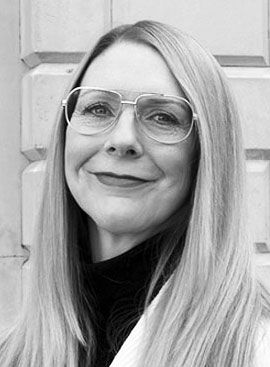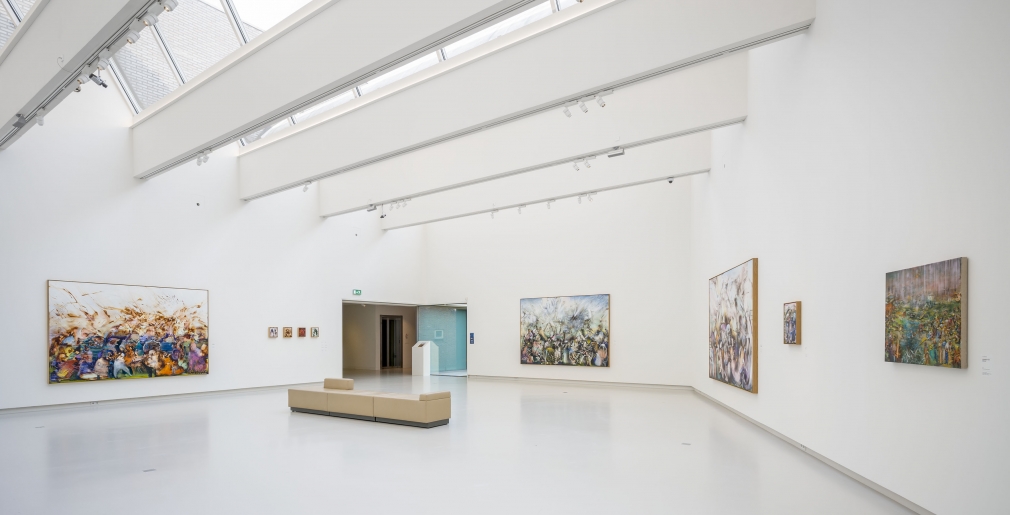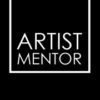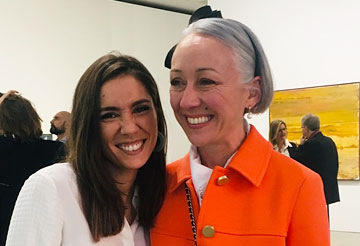Interview: ALKISTIS TSAMPOURAKI
Ceri Hand Curator, Director, Gallerist, Interviews

I first met Alkistis Tsampouraki in 2015, when we both worked at Simon Lee Gallery in London.
We shared a passion for learning, of facing fears, of not taking ourselves too seriously and to having fun, whilst making weird(er) things happen in the world. Alkistis is kind, considerate, loyal, and often hilariously honest. She has a great eye and is committed to supporting artists reaching new audiences internationally.

Alkistis Tsampouraki (left) with Anouchka Grose at the opening reception of Enrique Martinez Celaya’s exhibition The Mariner’s Meadow at Blain | Southern, London, May 2019
Alkistis Tsampouraki was born in Athens, Greece and has lived in London for the past 7 years. She completed her MA in History of Art at University College London, specialising in Expressionism, New Objectivity and Dada in Weimar Germany. She is a Video Programme Consultant for OUTERNET London, an arts and culture venue which will be launched in September 2020. From 2018-2019 she was working as an Artist & Museum Liaison at Blain Southern Gallery London/Berlin/New York and from 2015-2018 she was an Artist Liaison at Simon Lee Gallery London/Hong Kong/New York supporting artists internationally in strategising and building their careers. She has worked closely with emerging and established artists, prioritising commissioning and exhibiting new work, including off-site projects and installations, touring exhibitions and publishing catalogues, and editions. From September 2020 she will be Associate Director of Exhibitions & Special Projects at the Breeder Gallery, Athens.
What are you doing, reading, watching or listening to now, that is helping you to stay positive?
I am based in Athens, Greece and although the Covid crisis was more manageable here than in the UK we still had to spend more than two months in quarantine. I did a lot of reading during this time and the things I enjoyed the most was reading about Leonora Carrington’s life and more specifically The Seventh Horse which is a collection of her amazing short stories as well as Alejandro Jodorowsky’s account of Leonora's vital spiritual guidance for his life and work in The Spiritual Journey of Alejandro Jodorowsky. I also watched the documentary series Joseph Campbell and the Power of Myth which are six one-hour conversations between Joseph Campbell and journalist Bill Moyers. I love Campbell’s work and it fascinates me how in both ancient and contemporary religions and mythologies we still seek answers to the same set of questions.

Toby Ziegler, The Genesis Speech, 2017, Installation view, Freud Museum, London. Courtesy of the artist and Freud Museum, Photo Peter Mallet
What are your core values and drivers that you bring to the gallery? What do you care about?
My role is usually to keep a balance between the artists’ and the gallery’s needs and maintain a trustworthy relationship. Because an artist-gallery relationship is somewhat like a marriage that requires commitment even when things might get dysfunctional, I think what artists appreciate even more than bringing results is honesty, consistency with what you promise and integrity. So these are the most important values I bring to my work.
What do you enjoy the most about working with commercial galleries?
I like being part of a diverse team with a combination of people who are coming from different backgrounds and channels and who when putting their efforts together can achieve a certain goal. A commercial gallery can often also offer the resources needed to materialize projects and ideas. Personally, I have worked on a couple of institutional and public projects that wouldn’t be realised without the support of a commercial gallery. Still, this sometimes might lead to other imbalances but that’s another discussion…

Clare Woods, Rehumanised, 2018, Simon Lee Gallery, Hong Kong, Courtesy of the artist and Simon Lee Gallery, Photo Kitmin Lee
How do you gauge which artists and artworks will be interesting to audiences?
I think that there is no fixed recipe for success here. What makes me take real interest in someones’ work is that one of the ideas behind it is 'zeitgeisty' so to speak and that it somehow captures the present moment.
What kind of support or expertise do you offer or provide artists?
My role is to support an artist in building their career and profile not only through the gallery’s exhibitions and activities but internationally. So depending on each artist’s ambitions, I support them with day to day studio communication, production of artworks, catalogue production and distribution, research, development and implementation of public art projects, with establishing strategic partnerships with national and international institutions, with securing residency programmes, as well as with introducing curators, journalists and collectors to their work. Working closely with artists and having a more personal relationship also means that you often have to navigate through difficulties and challenges with them and offer emotional support.

Ali Banisadr, Foreign Lands, 2019, Installation view, Het Noordbrabants Museum, Den Bosch, The Netherlands, Courtesy of the artist and Het Noordbrabants Museum, Photo Joep Jacobs
What sales channels do you find work best for your artists?
A lot of galleries are focusing lately on digital platforms for reaching out to new audiences and widening their collectors base and it is true that some of these channels are successful. Especially now with the Covid situation these practices are becoming even more popular. Then art fairs are a major international hub for promoting someone’s work. But from my experience, the most successful route for nurturing lasting relationships with collectors is to cultivate their understanding and engagement with an artist’s practice by building his/her profile steadily and slowly through exhibitions, in conversation events, publications etc.
Can you describe one of your most rewarding relationships with an artist - what factors made it enjoyable?
I feel lucky in that sense, because I had the opportunity to work with amazing artists that were also incredible humans. With some of them I developed a more personal bond where there was a lot of trust and respect. When you really know someone and know their work and you manage to deliver something important to them, it is much more rewarding than just doing your job well. It’s like helping a dear friend and I find this very fulfilling.
What risks have you taken that perhaps did not go so well but you learnt the most from?
A few months ago I decided to leave a promising career in London and move back to Athens. It’s certainly difficult adapting to a new reality, but it’s important to do what feels right for you even when the world disagrees. I wouldn’t say however that this hasn’t gone well so far, but it was definitely a big risk for me and the outcome still remains to be seen.
What would you hope that people experience and learn from seeing one of your exhibitions or events?
The last months I have been developing and researching an exhibition concept. More than the curatorial idea, I am focused on how I want people to engage with what they see. I think that today we are more than ever detached from our intuition when perceiving things around us. When looking at a work of art, in many cases our first reaction is an attempt to analyze or de-contextualise what we see, stripping away its magical power. When this exhibition materialises, I really hope that it will give people permission to have a relationship with art that is of the spirit and not just of the mind, where feeling is privileged over knowing.
Do you have any advice for artists?
To stay real, focused and committed to their practice.
What helpful resources would you recommend to artists?
The answer can vary depending on the stage of someone’ s career. For an artist that is at the beginning of his/her career path, I think it’s helpful to follow the work of writers, curators etc. whose activity is close to their own quest; to be part of group shows with other artists with whom they share the same curiosity; to have a good online presence and in general to be active and out there. Residencies are also always a great way of building a network and opening up to new markets and territories. Although it can be challenging, when someone puts effort and good energy out there, their work will be noticed and gallerists will come after the artist rather than the other way around.
Follow Alkistis @alkistis_tsab @the_breeder_gallery
Please share this interview
And do subscribe to our newsletter for a monthly round-up of some useful creative hacks, insights, opportunities, and introductions. At the end of each month we host a free special 30 minute online subscriber event on Zoom, providing subscribers with the opportunity to meet and ask Ceri Hand any questions about creative careers or questions you might have in relation to mentoring.
Feel free to email or contact us via socials @cerihand
Coming Next...
An interview with Christian Viveros-Fauné (Santiago, 1965), gallerist, art fair director, art critic and curator.

